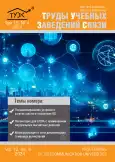Model and Methods of Traffic Routing in a Communication Network Using UAVs
- Authors: Kuznetsov K.A.1, Paramonov A.I.1, Muthanna A.S.1, Kucheryavy A.E.1
-
Affiliations:
- The Bonch-Bruevich Saint Petersburg State University of Telecommunications
- Issue: Vol 10, No 4 (2024)
- Pages: 62-72
- Section: ELECTRONICS, PHOTONICS, INSTRUMENTATION AND COMMUNICATIONS
- URL: https://journals.rcsi.science/1813-324X/article/view/263509
- EDN: https://elibrary.ru/VYMCTD
- ID: 263509
Cite item
Full Text
Abstract
About the authors
K. A. Kuznetsov
The Bonch-Bruevich Saint Petersburg State University of Telecommunications
Email: kuznetsov.sut@gmail.com
ORCID iD: 0009-0001-6167-2711
SPIN-code: 9601-1160
A. I. Paramonov
The Bonch-Bruevich Saint Petersburg State University of Telecommunications
Email: paramonov@sut.ru
ORCID iD: 0000-0002-4104-3504
SPIN-code: 6569-4460
A. S.A. Muthanna
The Bonch-Bruevich Saint Petersburg State University of Telecommunications
Email: muthanna.asa@sut.ru
ORCID iD: 0000-0003-0213-8145
SPIN-code: 2214-6441
A. E. Kucheryavy
The Bonch-Bruevich Saint Petersburg State University of Telecommunications
Email: akouch@sut.ru
ORCID iD: 0000-0003-0213-8145
SPIN-code: 1012-4238
References
- Taleb T., Benzaïd C., Lopez M.B., Mikhaylov K., Tarkoma S., Kostakos P., et al. 6G System Architecture: A Service of Services Vision // ITU Journal on Future and Evolving Technologies. 2022. Vol. 3. Iss. 3.
- Rec. ITU-T Technical Report (01/2020). Network 2030 ‒ Additional Representative Use Cases and Key Network Requirements for Network 2030.
- Rec. ITU-T Deliverable (10/2019). New Services and Capabilities for Network 2030: Description, Technical Gap and Performance Target Analysis.
- Li R. Network 2030. A Blueprint of Technology, Applications and Market Drivers Towards the Year 2030 and Beyond. 2019.
- Rec. ITU-T Technical Specification (06/2020). Network 2030 Architecture Framework.
- Волков А.Н., Мутханна А.С.А., Кучерявый А.Е., Бородин А.С., Парамонов А.И., Владимиров С.С. и др. Перспективные исследования сетей и услуг 2030 в лаборатории 6G Meganetlab СПБГУТ // Электросвязь. 2023. № 6. С. 5‒14. doi: 10.34832/ELSV.2023.43.6.001. EDN:CJSYLS
- Демидов Н.А. Исследование трафика 3d-видеопотока на имитационной модели // Электросвязь. 2024. № 3. С. 44‒48. doi: 10.34832/ELSV.2024.52.3.008. EDN:DNQCWX
- Rec. ITU Focus Group Technical Specification (12/2023). Definition of metaverse.
- Mane-Deshmukh P.V. Designing of Wireless Sensor Network to Protect Agricultural Farm from Wild Animals // i-Manager’s Journal on Information Technology. 2018. Vol. 7. Iss. 4. PP. 30‒36.
- Shannon C.E., Weaver W. The Mathematical Theory of Communication. Urbana: The University of Illinois Press,·1964.
- Akyildiz I.F., Han C., Hu Z., Nie S., Jornet J.M. Terahertz Band Communication: An Old Problem Revisited and Research Directions for the Next Decade // IEEE Transactions on Communications. 2022. Vol. 70. Iss. 6. PP. 4250‒4285. doi: 10.1109/TCOMM.2022.3171800
- Petrov V., Pyattaev A., Moltchanov D., Koucheryavy Y. Terahertz band communications: Applications, research challenges, and standardization activities // Proceedings of the 8th International Congress on Ultra Modern Telecommunications and Control Systems and Workshops (ICUMT, Lisbon, Portugal, 18‒20 October 2016). IEEE, 2016. PP. 183‒190. doi: 10.1109/ICUMT.2016.7765354
- results for "5g router" // Amazon. URL: https://www.amazon.com/5g-router/s?k=5g+router (Accessed 01.07.2024)
- Дорохова А.А., Парамонов А.И. Исследование трафика и качества обслуживания в самоорганизующихся сетях на базе БПЛА // Информационные технологии и телекоммуникации. 2016. Т. 4. № 2. С. 12‒25. EDN:XDCORF
- Варельджян К.С., Парамонов А.И., Киричек Р.В. Оптимизация траектории движения БПЛА в летающих сенсорных сетях // Электросвязь. 2015. № 7. С. 20‒25. EDN:UAYFOL
- Захаров М.В., Киричек Р.В., Парамонов А.И. Задача распределения ресурсов в группах БПЛА // Информационные технологии и телекоммуникации. 2015. Т. 3. № 1. С. 62‒70. EDN:TUXWKP
- Вишневский В.М. Методы и алгоритмы проектирования и реализации привязных высотных беспилотных телекоммуникационных платформ // XIII Всероссийское совещание по проблемам управления ВСПУ-2019 (Москва, Россия, 17–20 июня 2019 г.). М.: Институт проблем управления им. В.А. Трапезникова РАН, 2019. С. 40‒42. doi: 10.25728/vspu.2019.0040. EDN:KFCQMJ
- Факторный, дискриминантный и кластерный анализ. Пер. с англ. М.: Финансы и статистика, 1989. 215 с.
- 3. Clustering // Scikit-learn. URL: https://scikit-learn.org/stable/modules/clustering.html (Accessed 01.07.2024)
- Марочкина А.В. Моделирование и кластеризация трехмерной сети интернета вещей с применением метода оценки фрактальной размерности // Электросвязь. 2023. № 6. С. 60‒66. doi: 10.34832/ELSV.2023.43.6.008. EDN:ZBNQKI
- Загоруйко Н.Г., Ёлкина В.Н., Лбов Г.С. Алгоритмы обнаружения эмпирических закономерностей. Новосибирск: Наука, 1985. 110 с.
- Викулов А.С., Парамонов А.И. Модель канала OFDM в задаче оценки эффективности сети IEEE 802.11 // Инфокоммуникационные технологии. 2018. Т. 16. № 3. С. 290‒297. doi: 10.18469/ikt.2018.16.3.06. EDN:EMWAAZ
- Рекомендация МСЭ-R P.1238-9 (06/2017). Данные о распространении радиоволн и методы прогнозирования для планирования систем радиосвязи внутри помещений и локальных зоновых радиосетей в частотном диапазоне 300 МГц–100 ГГц.
- Daley D.J., Vere-Jones D. An Introduction to the Theory of Point Processes. Volume I: Elementary Theory and Methods. Springer Science & Business Media, 2006. 471 p.
- Препарата Ф., Шеймос М. Вычислительная геометрия: Введение. Пер. с англ. М.: Мир, 1989. 478 с.
- Майника Э. Алгоритмы оптимизации на сетях и графах. Пер. с англ. М.: Мир. 1981. 323 с.
Supplementary files






